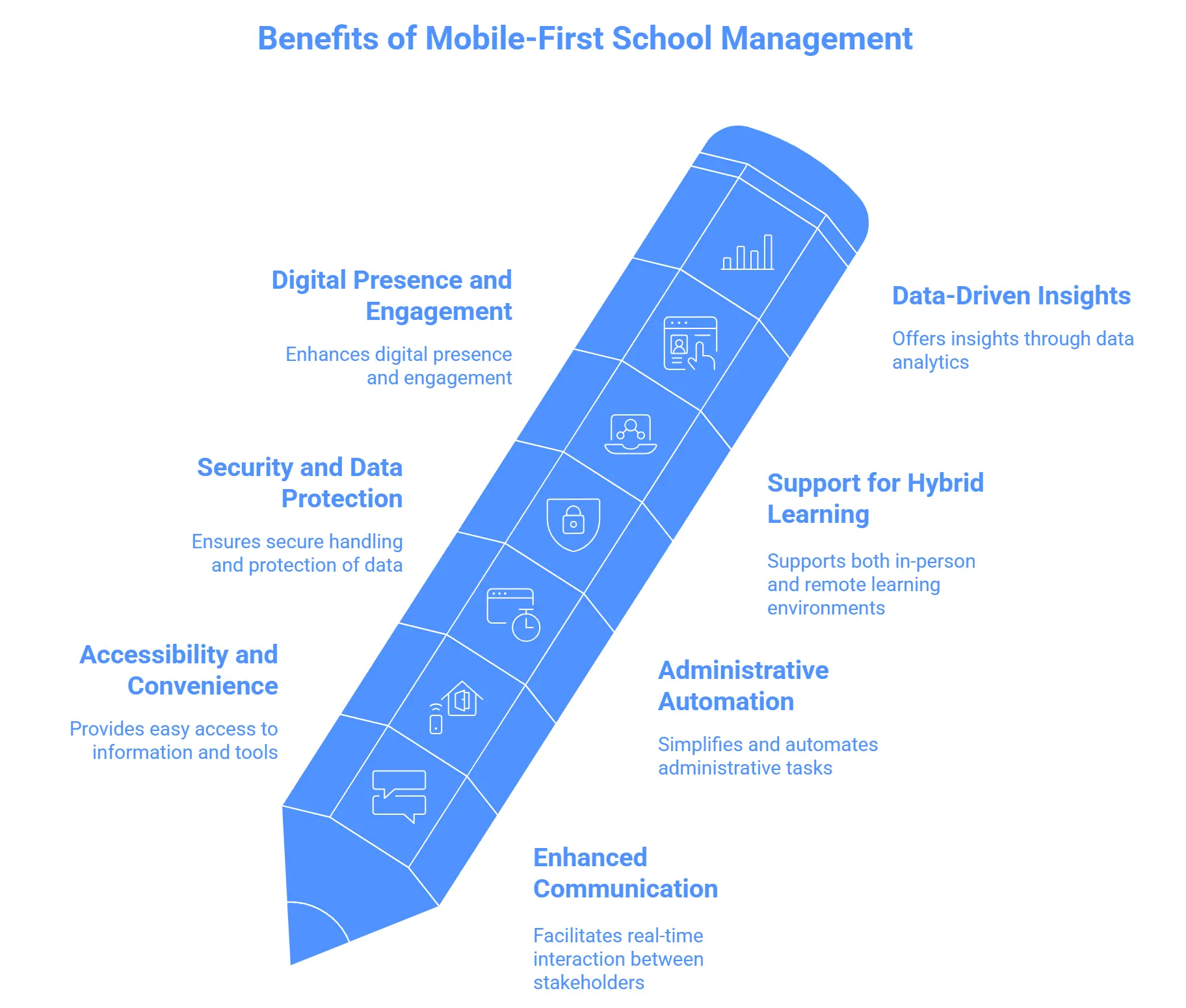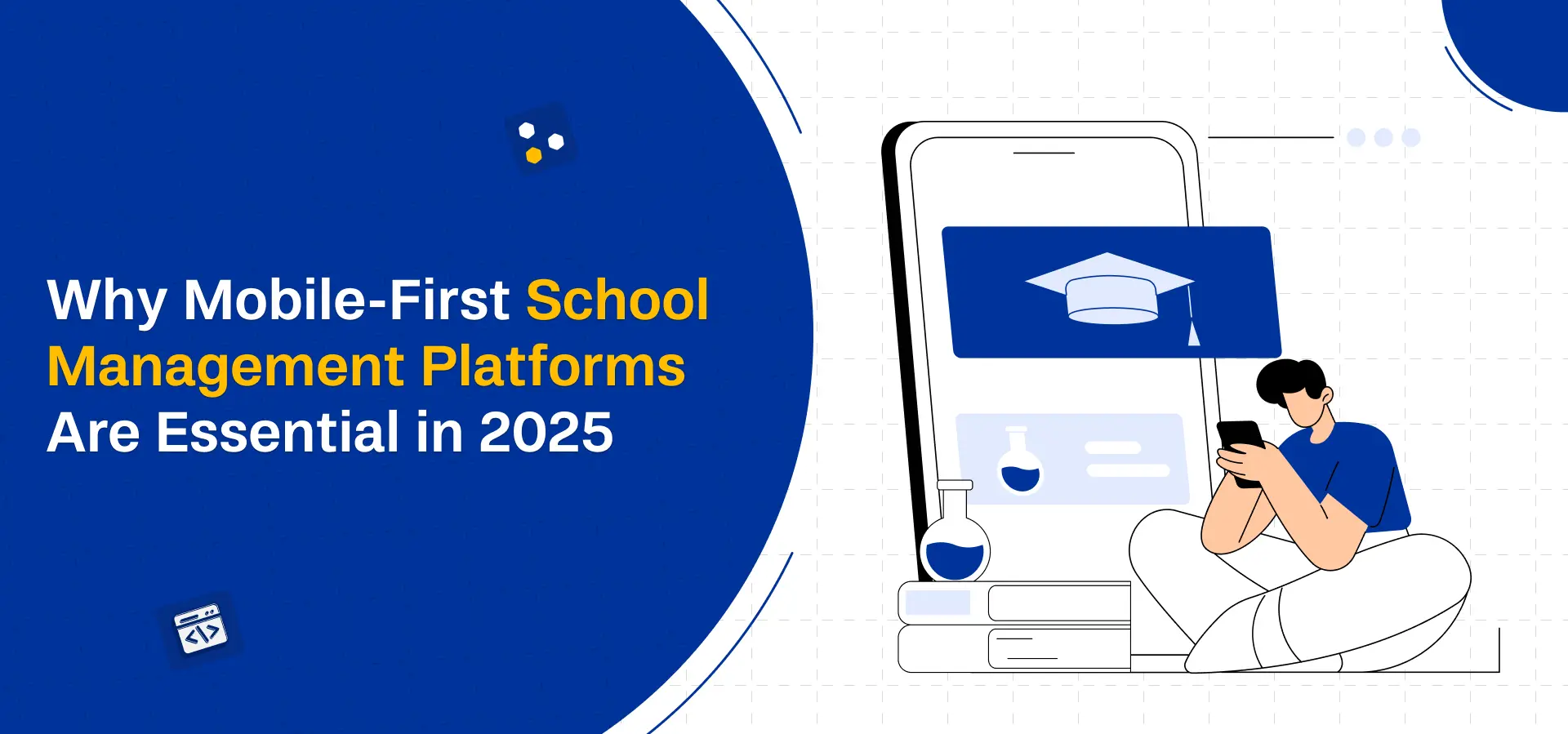The educational environment has witnessed unbelievable change in the last few years with technology taking the centre stage in the learning institutions of today. The movement towards mobile-first solutions is one of the trends that becomes prominent as we go through 2025. Schools around the globe are appreciating that a powerful school management system should focus more on mobile access to ensure that the needs of students, parents, teachers, and administrators are being addressed.
Gone is the era when desktop-based software could be sufficient to meet dynamic needs of modern-day education. The current education management platform needs to provide the ability to withstand transversal functionality through smartphones and tablets to facilitate the availability of important information to the stakeholders, no matter their locations. This paper discusses the reasons why educational institutions will be unable to live without mobile-first school management system SaaS solutions in 2025.
The Mobile Revolution in Education
The figures are self-explanatory. More than 85% of the internet users all over the world use online services with the use of mobile phones. The verification of academic progress of children by the parent, the record keeping of attendance by teachers, the performance of an institution performed by administrators, all these actions seem to be on smartphones more and more. A conventional institute management system software that does not provide an outstanding mobile experience risks losing all its users.
Mobile-first design philosophy is one that places smart phones as the core of the user experience instead of an afterthought. This will make sure that all features of an online classroom management software works perfectly on smaller screens with touch-friendly interfaces and responsive designs that will dynamically change with different device sizes.
Advantages of Mobile-First School Management Platforms

1. Enhanced Communication and Real-Time Connectivity
Any educational institution lives on communication. A mobile-first student management system website provides real-time communication among all the stakeholders. Parents get instant updates on the attendance status of their child, grades or any behavioral issues on their smart phones. With just a few taps, teachers can send homework reminders, schedule updates, or be able to send emergency alerts to whole classes.
Push notifications are used to make sure that important news does not get lost in the mailbox. It can be a school shutdown, last minute parent-teacher meeting or the need to pay your fee within 20 minutes, mobile-first platforms ensure that the message gets received immediately. This connectivity was not possible with the old systems of desktops and has become a foundation of school management system SaaS solutions today.
2. Unprecedented Accessibility and Convenience
In 2025, the success of any digital platform will be determined by accessibility. The mobile-first multi school management system will guarantee that geographical boundaries and time constraints do not restrict access to educational materials any more. Parents who are on multiple shifts would be able to check the progress of their child during the breaks. On the commute to work, teachers are able to update lesson plans. Administrators are able to grant leave requests anywhere in the world.
This access is not only convenient, but also encourages inclusiveness. Smartphones can enable parents not able to access a computer at home to be fully involved in the education of their children. The education management platform will become more or less democratic thus allowing all the stakeholders to access information equally irrespective of their access to technological resources as well as physical location.
3. Streamlined Administrative Automation
The time spent on the administrative side is endless and the time would be utilized by educators to teach and mentor. Online classroom management software that is mobile first automates the routine processes which significantly slashes the administrative load. Tracking of attendance, generation of grades, issuance of report cards, fees management, schedule of the timetable, and allocation of resources, all these activities can be automated and accessed using mobile devices.
Take the example of the old way of attendance marking: teachers would write names down in registers and transfer this information to spreadsheets and then produce reports. An institute management system software in mobile-first is engineered to enable teachers to record attendance with just a couple of taps and this data would automatically reflect on the dashboards and send notifications to parents of students who are absent. This automation will save hours per week as well as increase accuracy and accountability.
4. Robust Security and Data Protection
Security issues are among the highest considerations of educational institutions relating to sensitive information concerning students. Newer mobile-first school management system platforms have enterprise-level security features that have been expressly built to operate in mobile environments. Biometric authentication, encrypted data transmission, role-based access controls and secure cloud storage will keep confidential information safe.
Mobile devices have distinct security benefits because of their applications such as fingerprint scanning and facial recognition, which offer more security than the traditional password-based system. Moreover, the trusted school management system SaaS vendors provide automatic security upgrades, meaning that institutions receive the most recent protection against new threats with no human intervention.
5. Seamless Support for Hybrid and Remote Learning
Hybrid learning model is a phenomenon that has made its way to permanency in contemporary education since it is not a temporary solution. An online classroom management software that is mobile-first gives the flexibility required to accommodate diverse learning settings. Through their mobile devices, students are able to view course content, submit assignments, engage in conversations, and take virtual classes.
This flexibility is equally to the advantage of teachers. They are able to deliver live classes, provide multimedia resource sharing, grading and providing feedback anywhere. The education management platform turns into a coordinated center that transcends physical and virtual classrooms and provides continuity of learning in spite of any situation. This feature was essential in the recent times of global disturbances and the ability is essential to admit students with special needs or health limitations.
6. Comprehensive Digital Presence and Engagement
Learning institutions in 2025 are aware that their online identity is not simply limited to their websites and social media. The mobile first student management system website is the point of greatest interaction between the institution and its community. Potential parents who research on schools are increasingly demanding more mobile-enabled portals in which they can view the information about the curriculum, facilities, and admissions, and the performance of the institutions.
Existing students and parents prefer using the mobile platform, which allows them to access convenient interfaces as well as use useful features. Mobile-based news updates, event calendar, photo gallery, showcases of achievements as well as interactive feedback mechanisms enhance the bond between the institutions and the communities. This higher interaction would translate to a higher level of satisfaction, retention and positive word-of-mouth advertising.
7. Data-Driven Insights and Analytics
Mobile-first platforms produce untold volumes of valuable data regarding student performance, teacher effectiveness, resource use, and the organizational direction. The complex multi school management system then converts this raw data into actionable information using user-friendly dashboards that can be accessed using mobile devices.
Administrators can see the number of enrolled students in real time, check their status on fee collection, students who need extra attention, and the effectiveness of teaching all on their smart phones. These learnings allow taking actions beforehand and reacting quickly to new problems. Educators will be able to examine the progress patterns of each student and respond to them by tailoring their teaching plans, whereas parents will see the academic history of their child in the form of clear and mobile-friendly reports.
Integrating Essential Features into Mobile-First Platforms
The implementation of a mobile-first institute management system software should be done with careful integrations of features that support the needs of various stakeholders that would make it a successful implementation. The following is the way critical capabilities can be integrated:
Attendance and Time Management: GPS verification, QR code scanning, and biometric can be used in mobile applications, which guarantee proper attendance monitoring. There are automated notifications that keep the parents updated and provide detailed reports to the administrators.
Academic Management: Mobile interfaces should work perfectly in course scheduling, syllabus allocation, assignment, grade recording and report cards. Learning management systems integration generates an integrated academic ecosystem.
Financial Management: The payment gateways, invoice generators, payment tracking, scholarship applications, and expense reporting systems should provide secure and mobile-responsive experiences. Parents would like the convenience of making payments on their mobile phones.
Communication Tools: in-built messaging features, announcement boards, video conferencing, and multi-language features make it easy to communicate with the whole learning community.
Transport and Safety Features: School buses are tracked in real-time with GPS technology, optimize routes, manage drivers, and offer emergency alerts to parents, and ease logistics to administrators.
Library and Resource Management: digital cataloguing, book reservations, access to e-resources, and tracking of fines are some of the services that take library services beyond the physical realm.
Health and Wellness: Medical record administration, vaccination history, counseling schedule planning and wellness resource libraries contribute to the holistic development of students.
Conclusion
Migration to mobile-first school management systems is not a technological upgrade, but a paradigm shift in the way educational institutions are managed and related to their community. With the march of 2025, any institution that adopts mobile-first online classroom management software will be in the vanguard of education innovations.
The benefits cannot be disputed: the communication is increased, accessibility is improved, automation is streamlined, security is robust, the learning process is supported by hybrid learning, the digital presence is enhanced, and the insights are data-driven. All these advantages revolutionize how education is being delivered, the efficiency of administration, and satisfaction of stakeholders.
When choosing an appropriate education management platform, it is essential to have a closer look at mobile capabilities, the completeness of the features, the level of security, scalability, and the support of the vendor. Institutions should put more emphasis on solutions that are able to satisfy present needs but also adapt to these future education challenges and opportunities.
It ceases to be whether or not to apply mobile-first technology but the speed with which institutions can apply these transformative platforms. As the world is becoming more mobile every day, schools that do not focus on mobile-first solutions are at risk of being overtaken by their competitors, as well as failing to satisfy communities used to smooth digital experiences.
An all-encompassing, mobile-first school management system SaaS solution would be an investment in the future of education as a whole, a future in which technology would empower teachers, be more interactive with learners, alleviate parental anxiety, and help schools accomplish their mission more easily than ever before. It is time to move to this mobile-first future.
Get the eSchool SaaS Now

.png)